About
D.Waste is an AI-powered waste management platform that empowers individuals and communities to make smarter waste disposal decisions. Our app uses AI to identify types of waste, guides users on proper disposal, and rewards sustainable behavior through a gamified points system.
D.Waste isn't just for individuals — we partner with educational institutions, organizations, and government bodies to promote large-scale behavioral change and sustainability:
- Educational Institutions: D.Waste helps schools and universities integrate environmental learning into the classroom. Our tools include real-time waste identification, sustainability tracking dashboards, and interactive educational games such as DSort that make learning about waste sorting fun and engaging for kids.
- Organizations: We support workplaces and nonprofits in running green initiatives by offering smart bin tagging, staff engagement through our reward system, and monthly sustainability reports to measure impact.
- Government Bodies: D.Waste provides municipalities and local governments with the tools to raise awareness, reduce landfill dependency, and monitor community behavior. Our analytics dashboard delivers valuable data for designing better waste policies and public outreach campaigns.
We also build interactive web-based games like DSort to teach young users how to sort waste through play. These games include drag-and-drop mechanics and puzzles that reward learning with points and badges. They are accessible on all devices and can be integrated into classroom or community outreach programs.
Available on the App Store and Google Play Store, D.Waste also helps users locate recycling centers, access educational materials, and track their personal impact over time.
Partner with us — Whether you're a school, NGO, or city council, D.Waste is ready to collaborate and help you build a cleaner, smarter future. Get in touch to start your sustainability journey with us.
We care about you
Privacy by Design
We respect your privacy. DWaste does not sell or share your data, and we never track your in-app activity. Your experience is yours alone.
Ethics by Design
We avoid addictive design patterns like infinite scroll or autoplay. Our goal is to educate and empower not to exploit attention.
100% Open Research
DWaste’s methods and data sources are fully transparent. We invite collaboration, peer review, and shared innovation through open research.
Education & Community
We work with schools, organizations, and governments to make waste education accessible through AI tools, analytics, and interactive games like DSort.
Science That Powers D.Waste
Our technology is backed by peer-reviewed research and has been cited by many researchers worldwide. Over the years, we have published multiple papers, presented at international workshops and summits, and released open datasets that advance the global understanding of waste management and recycling.
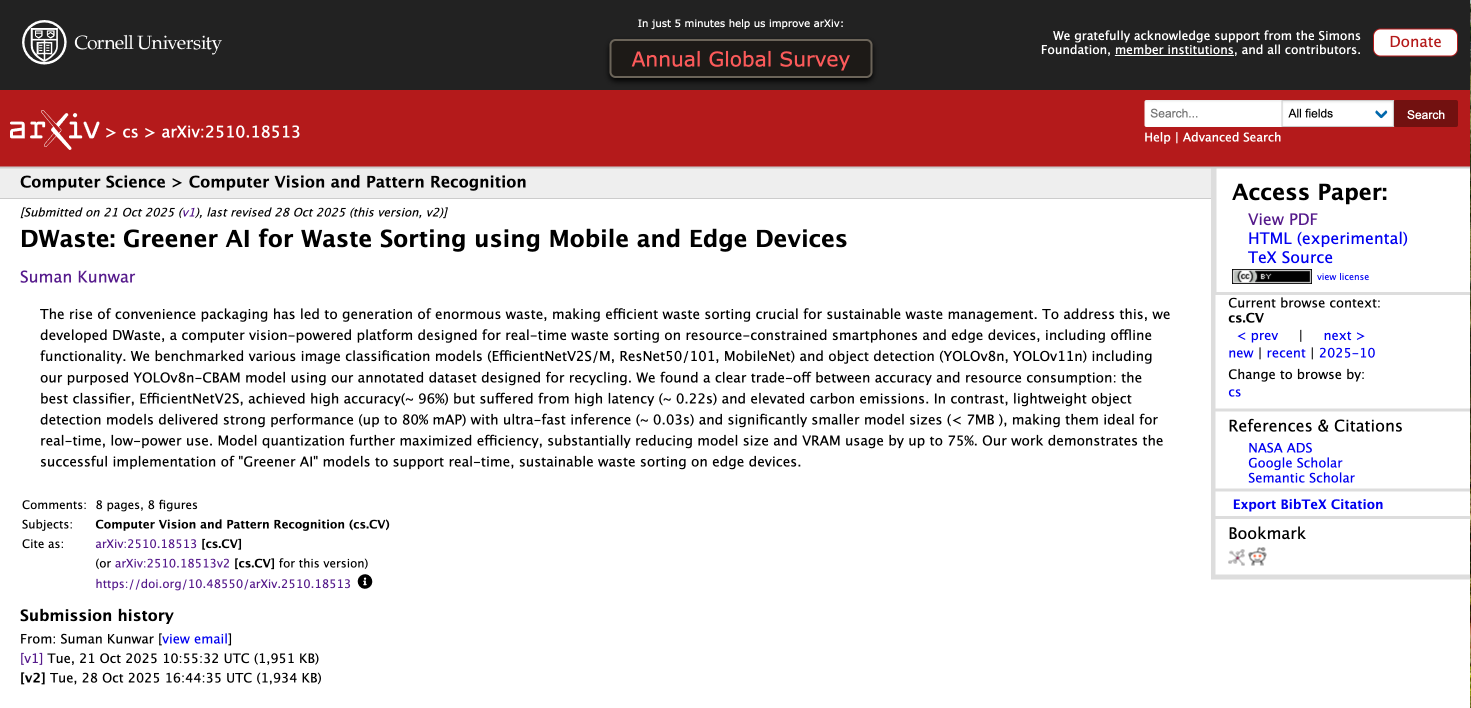
DWaste: Greener AI for Waste Sorting using Mobile and Edge Devices
Oct 2025
arXiv Preprint
The rise of convenience packaging has led to generation of enormous waste, making efficient waste sorting crucial for sustainable waste management. To address this, we developed DWaste, a computer vision-powered platform designed for real-time waste sorting on resource-constrained smartphones and edge devices, including offline functionality. We benchmarked various image classification models (EfficientNetV2S/M, ResNet50/101, MobileNet) and object detection (YOLOv8n, YOLOv11n) including our purposed YOLOv8n-CBAM model using our annotated dataset designed for recycling. We found a clear trade-off between accuracy and resource consumption: the best classifier, EfficientNetV2S, achieved high accuracy(~ 96%) but suffered from high latency (~ 0.22s) and elevated carbon emissions. In contrast, lightweight object detection models delivered strong performance (up to 80% mAP) with ultra-fast inference (~ 0.03s) and significantly smaller model sizes (< 7MB ), making them ideal for real-time, low-power use. Model quantization further maximized efficiency, substantially reducing model size and VRAM usage by up to 75%. Our work demonstrates the successful implementation of 'Greener AI' models to support real-time, sustainable waste sorting on edge devices.
View →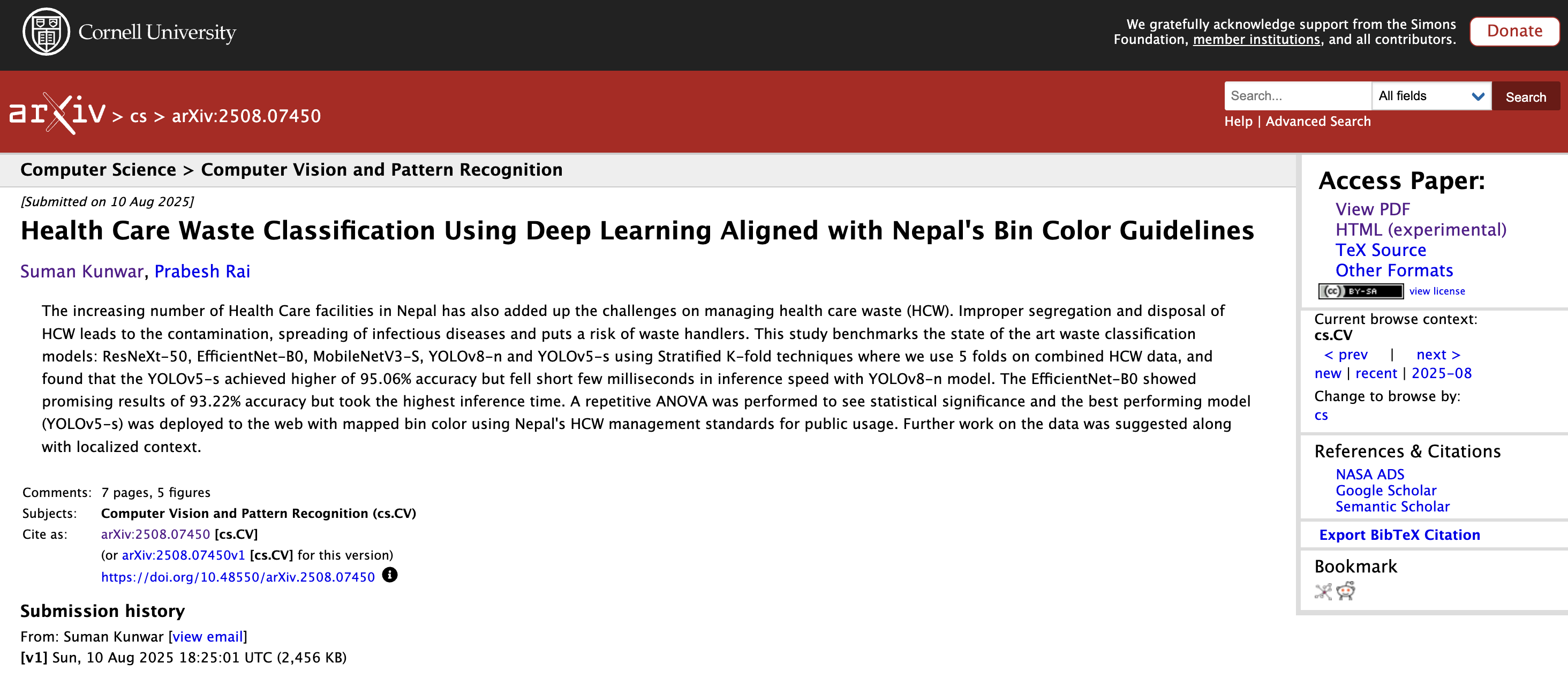
Health Care Waste Classification Using Deep Learning Aligned with Nepal's Bin Color Guidelines
Aug 2025
arXiv Preprint
The increasing number of Health Care facilities in Nepal has added up the challenges on managing health care waste (HCW). Improper segregation and disposal of HCW leads to contamination, spreading of infectious diseases and risk for waste handlers. This study benchmarks the state of the art waste classification models: ResNeXt-50, EfficientNet-B0, MobileNetV3-S, YOLOv8-n and YOLOv5-s using stratified 5-fold cross-validation technique on combined HCW data. YOLOv5-s achieved the highest accuracy (95.06%) but fell short with the YOLOv8-n model in inference speed with few milliseconds. The EfficientNet-B0 showed promising results of 93.22% accuracy but took the highest inference time. Following a repetitive ANOVA test to confirm the statistical significance, the best performing model (YOLOv5-s) was deployed to the web with bin color mapped using Nepal's HCW management standards. Further work is suggested to address data limitation and ensure localized context.
View →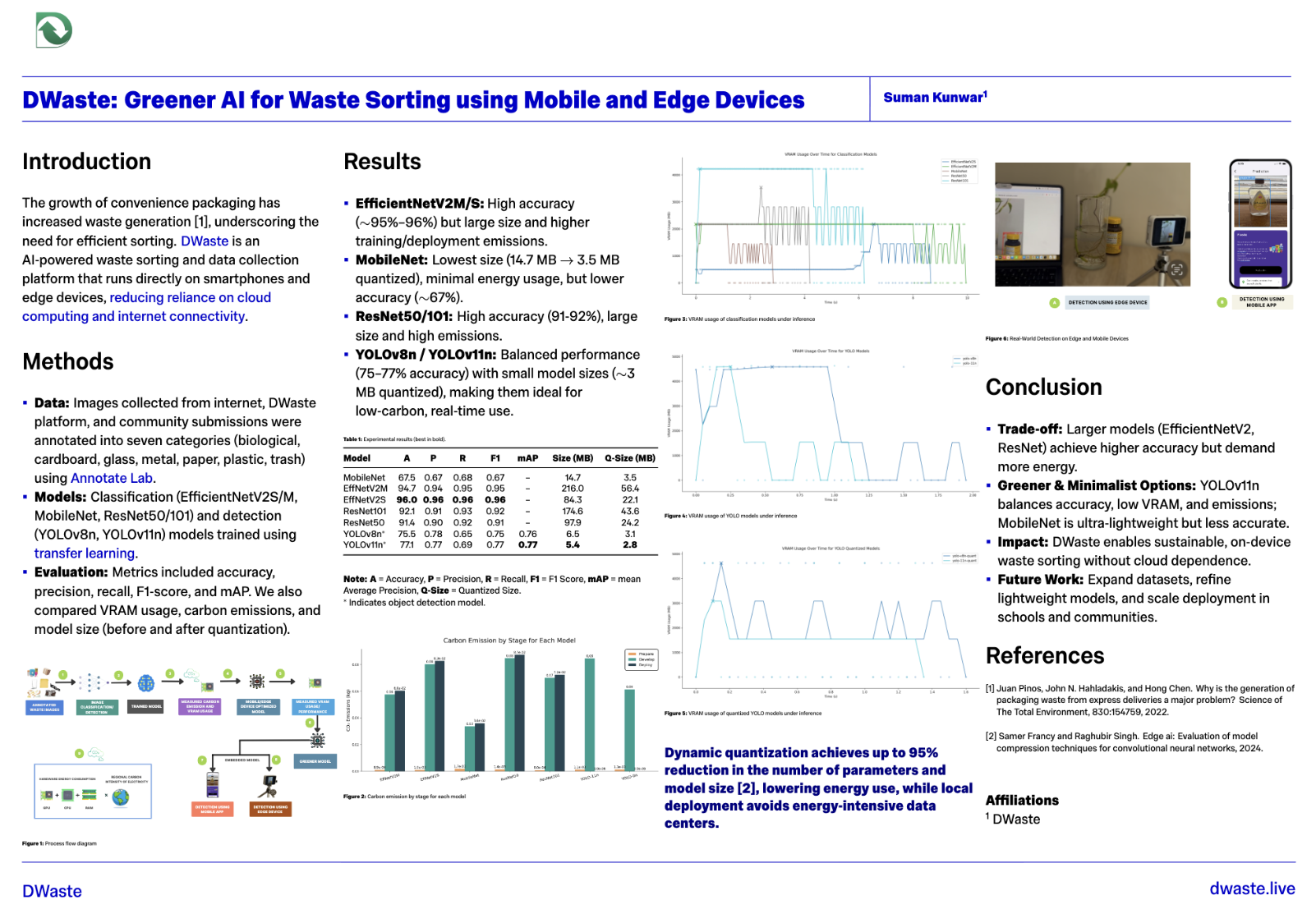
DWaste: Greener AI for Waste Sorting using Mobile and Edge Devices
Oct 2025
AI + Environment Summit
The rise of the convenience packaging has led to generation of enormous waste. Sorting these waste is crucial in waste management. To aid the sorting process we provide an AI powered platform call DWaste that runs on smartphones and edge devices, even without internet access. We trained image classification (EfficientNetV2S/M, ResNet50/101) and light weighted object detection (YOLOv8n, YOLOv11n) models using a subset of our own Waste dataset and annotated it using the custom tool Annotated Lab. Among these models, EfficientNetV2S achieved 96% accuracy but took longer inference time (0.22s) and higher carbon emission, whereas the lightweight object detection delivered 76–77% mAP, with low emissions, ultra-fast inference (~0.03s) with smaller model sizes(<7MB), making them ideal for real-time use on low-power devices. Quantization further reduced model size and VRAM usage by nearly half. Our experiment show how greener AI model support real-time waste sorting to manage waste.
View →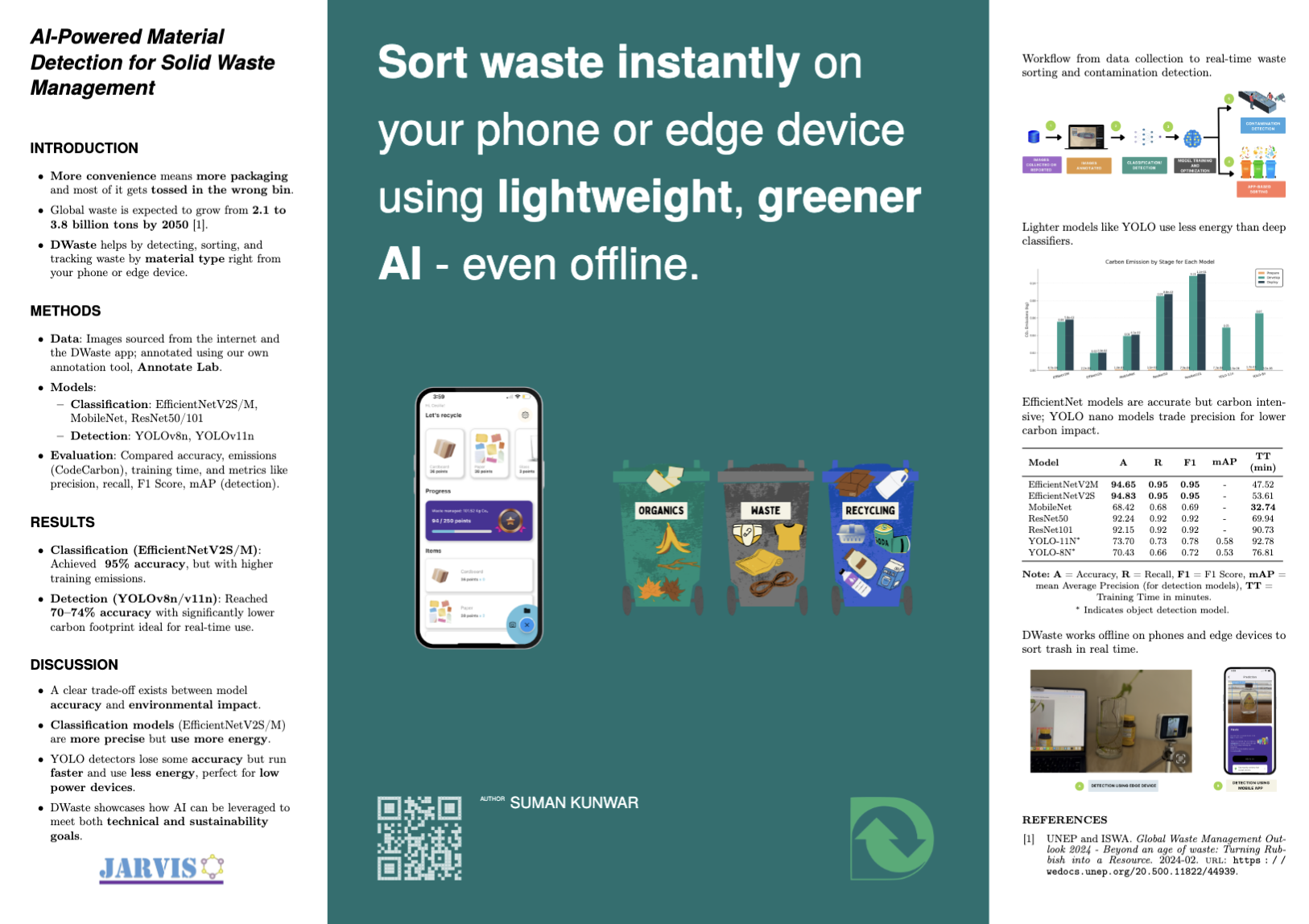
AI-Powered Material Detection for Solid Waste Management
Jul 2025
Artificial Intelligence for Materials Science (AIMS) Workshop
DWaste uses lightweighted and greener AI to detect, sort and track waste using mobile and edge devices -even offline. This poster presents an overview of the end-to-end workflow of DWaste, from data collection and annotation (using our custom tool, Annotate Lab) to model training and evaluation. We benchmark a subset of our dataset (Garbage Dataset) with several classification models (EfficientNetV2S/M, MobileNet, ResNet50/101) and detection models (YOLOv8n/v11n), with accuracy, carbon emissions (using CodeCarbon), and training time. Results show the EfficientNet achieved higher accuracy (~95%); YOLO models offered significantly lower emissions and faster performance, making them ideal for real-time, energy-efficient deployment. DWaste shows the use of greener AI to sort and manage waste.
View →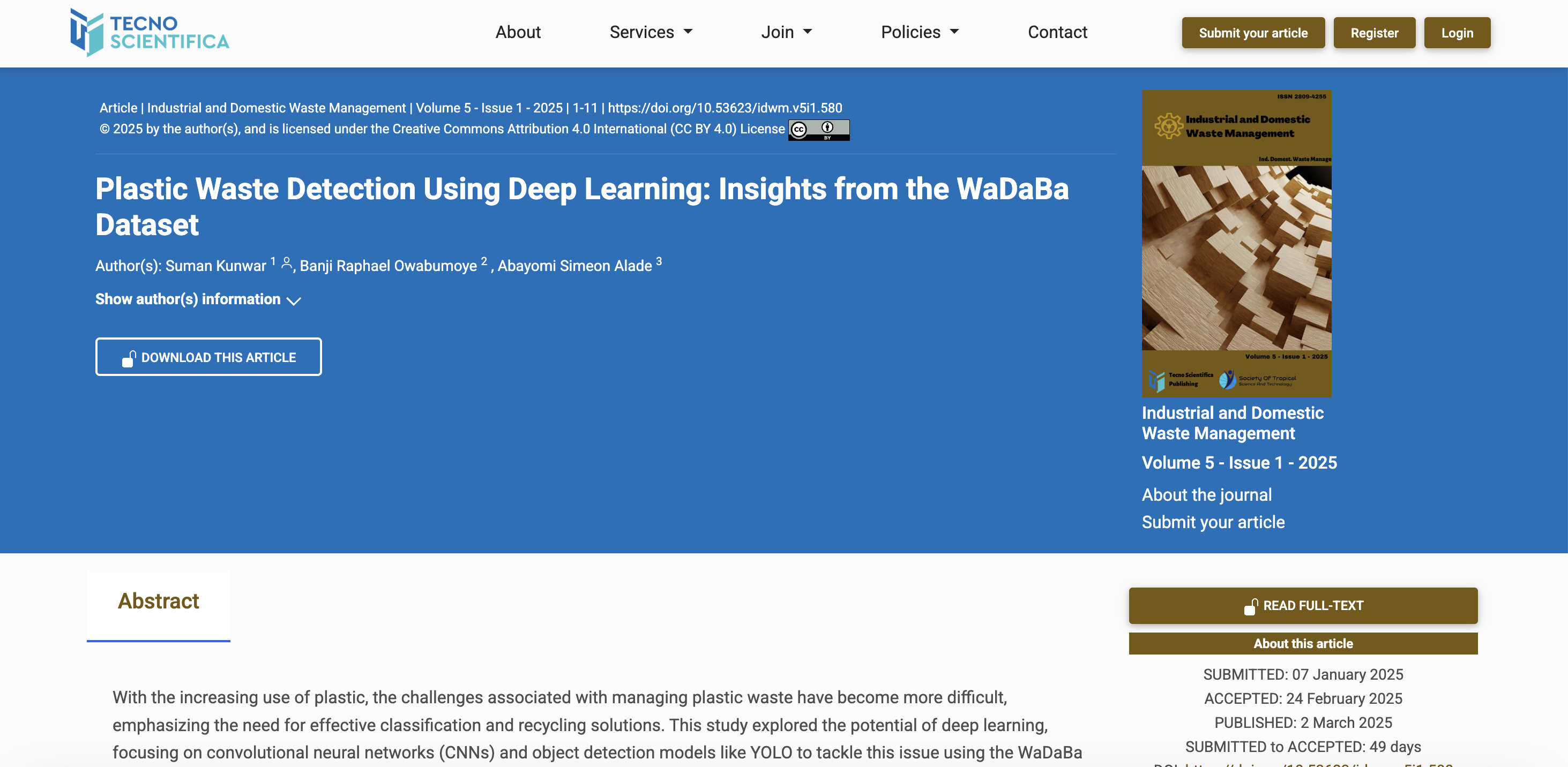
Plastic Waste Detection Using Deep Learning: Insights from the WaDaBa Dataset
Mar 2025
Industrial and Domestic Waste Management
With the increasing use of plastic, the challenges associated with managing plastic waste have become more difficult, emphasizing the need for effective classification and recycling solutions. This study explored the potential of deep learning, focusing on convolutional neural networks (CNNs) and object detection models like YOLO to tackle this issue using the WaDaBa dataset. The results indicated that YOLO-11m achieved the highest accuracy (98.03%) and mAP50 (0.990), while YOLO-11n performed similarly but achieved the highest mAP50 (0.992). Lightweight models like YOLO-10n trained faster but had lower accuracy, whereas MobileNetV2 demonstrated impressive performance (97.12% accuracy) but fell short in object detection. YOLO-11n had the fastest inference time (0.2720s), making it ideal for real-time detection, while YOLO-10m was the slowest (5.9416s). Among CNNs, ResNet50 had the best inference time (1.3260s), whereas MobileNetV2 was the slowest (1.4991s). These findings suggested that by balancing accuracy and computational efficiency, these models could contribute to scalable waste management solutions. The study recommended increasing the dataset size for better generalization, enhancing augmentation techniques, and developing real-time solutions.
View →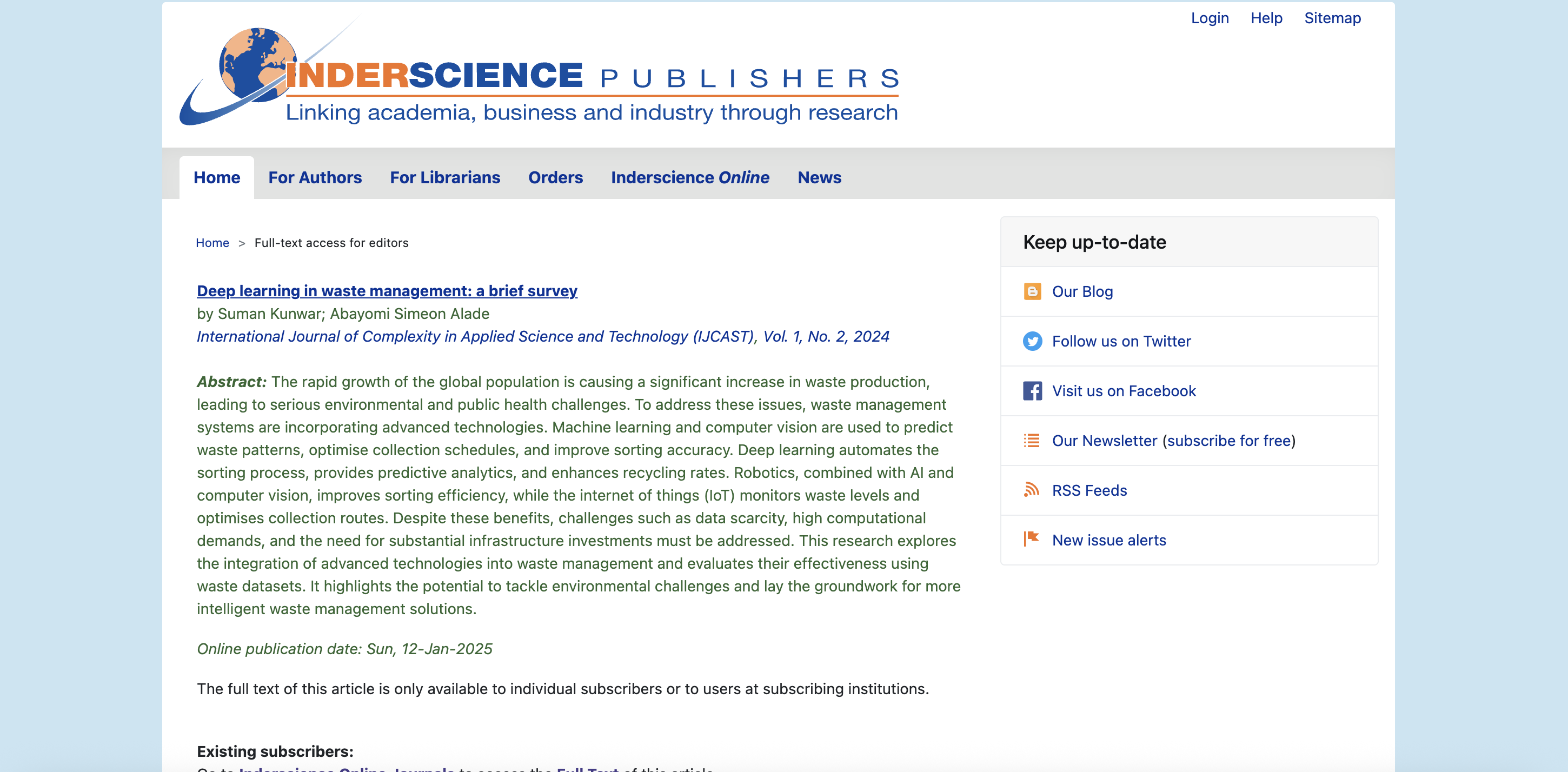
Deep Learning in Waste Management: A Brief Survey
Jan 2025
International Journal of Complexity in Applied Science and Technology
The rapid growth of the global population is causing a significant increase in waste production, leading to serious environmental and public health challenges. To address these issues, waste management systems are incorporating advanced technologies. Machine learning and computer vision are used to predict waste patterns, optimise collection schedules, and improve sorting accuracy. Deep learning automates the sorting process, provides predictive analytics, and enhances recycling rates. Robotics, combined with AI and computer vision, improves sorting efficiency, while the internet of things (IoT) monitors waste levels and optimises collection routes. Despite these benefits, challenges such as data scarcity, high computational demands, and the need for substantial infrastructure investments must be addressed. This research explores the integration of advanced technologies into waste management and evaluates their effectiveness using waste datasets. It highlights the potential to tackle environmental challenges and lay the groundwork for more intelligent waste management solutions.
View →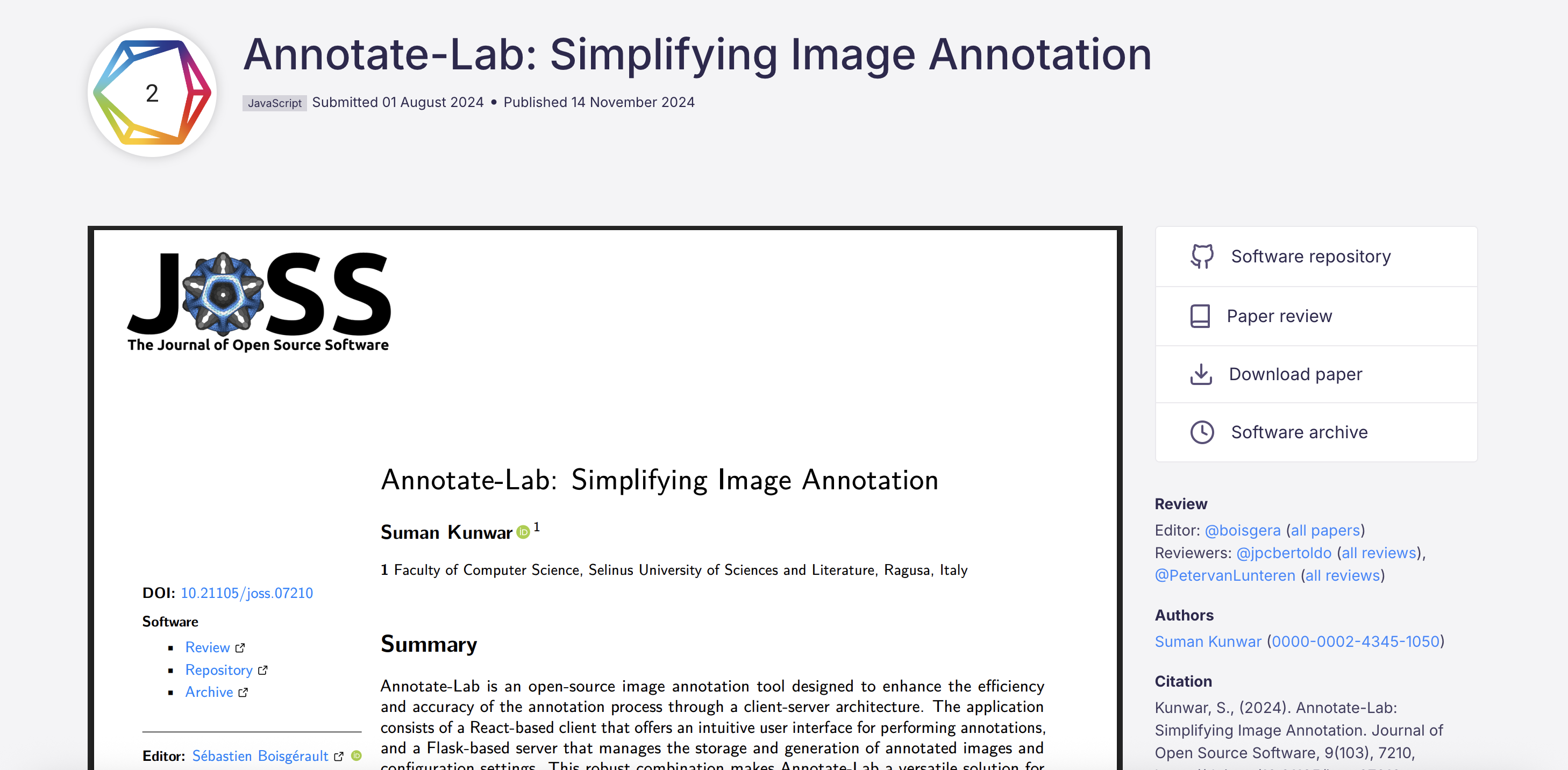
Annotate-Lab: Simplifying Image Annotation
Nov 2024
The Journal of Open Source Software
Annotate-Lab is an open-source image annotation tool designed to enhance the efficiency and accuracy of the annotation process through a client-server architecture. The application consists of a React-based client that offers an intuitive user interface for performing annotations, and a Flask-based server that manages the storage and generation of annotated images and configuration settings. This robust combination makes Annotate-Lab a versatile solution for various fields requiring precise image labeling, such as machine learning, medical imaging, and autonomous driving.
View →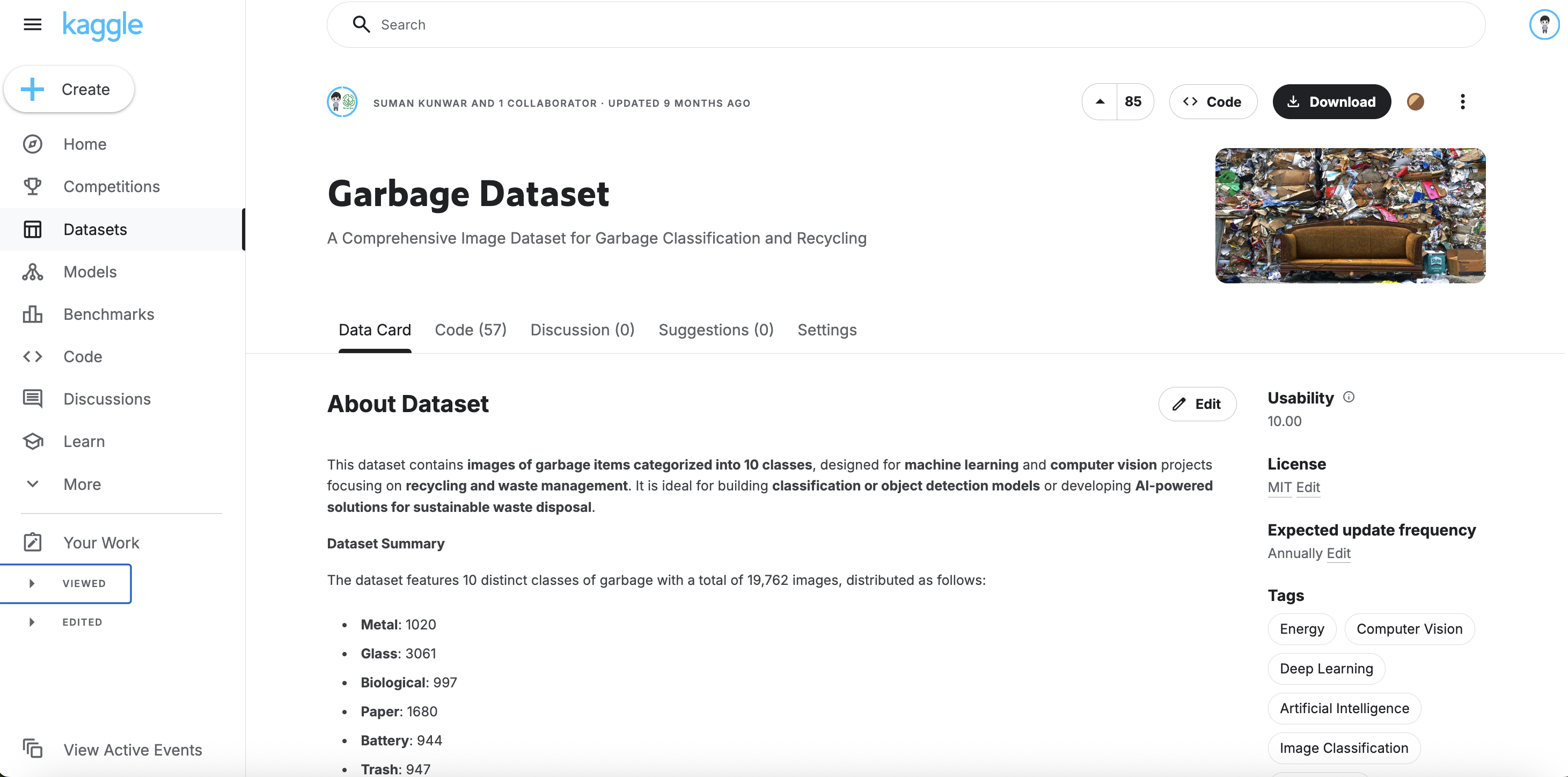
Garbage Dataset
Dec 2023
Kaggle
This dataset contains images of garbage items categorized into 10 classes, designed for machine learning and computer vision projects focusing on recycling and waste management. It is ideal for building classification or object detection models or developing AI-powered solutions for sustainable waste disposal.
View →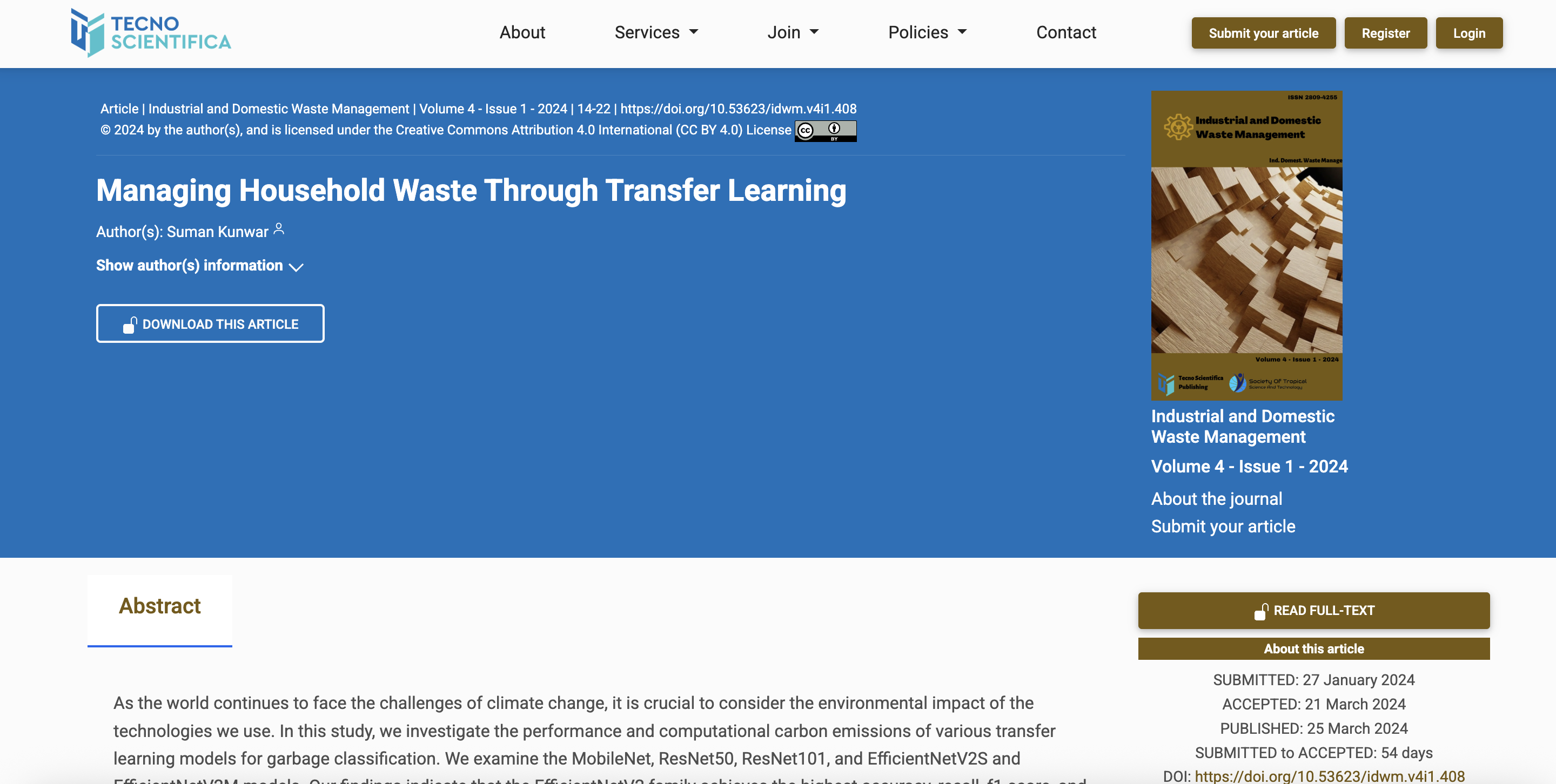
Managing Household Waste Through Transfer Learning
Mar 2024
Industrial and Domestic Waste Management
As the world continues to face the challenges of climate change, it is crucial to consider the environmental impact of the technologies we use. In this study, we investigate the performance and computational carbon emissions of various transfer learning models for garbage classification. We examine the MobileNet, ResNet50, ResNet101, and EfficientNetV2S and EfficientNetV2M models. Our findings indicate that the EfficientNetV2 family achieves the highest accuracy, recall, f1-score, and IoU values. However, the EfficientNetV2M model requires more time and produces higher carbon emissions. ResNet50 outperforms ResNet110 in terms of accuracy, recall, f1-score, and IoU, but it has a larger carbon footprint. We conclude that EfficientNetV2S is the most sustainable and accurate model with 96.41% accuracy. Our research highlights the significance of considering the ecological impact of machine learning models in garbage classification.
View →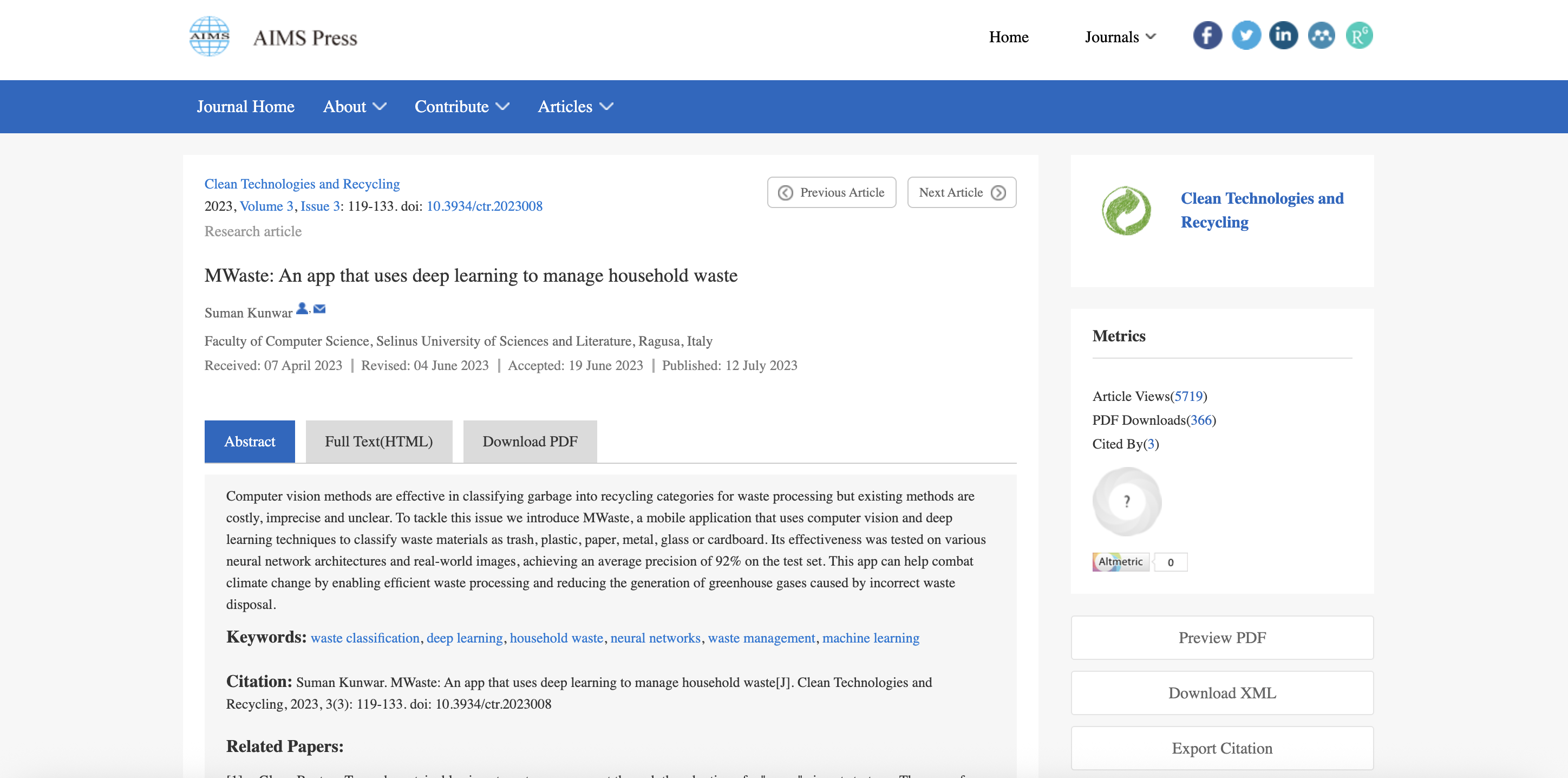
MWaste: An app that uses deep learning to manage household waste
Jul 2023
Clean Technologies and Recycling
The rapid growth of the global population is causing a significant increase in waste production, leading to serious environmental and public health challenges. To address these issues, waste management systems are incorporating advanced technologies. Machine learning and computer vision are used to predict waste patterns, optimise collection schedules, and improve sorting accuracy. Deep learning automates the sorting process, provides predictive analytics, and enhances recycling rates. Robotics, combined with AI and computer vision, improves sorting efficiency, while the internet of things (IoT) monitors waste levels and optimises collection routes. Despite these benefits, challenges such as data scarcity, high computational demands, and the need for substantial infrastructure investments must be addressed. This research explores the integration of advanced technologies into waste management and evaluates their effectiveness using waste datasets. It highlights the potential to tackle environmental challenges and lay the groundwork for more intelligent waste management solutions.
View →Contribute
DWaste is a free, ad-free platform built for impact and we welcome your support to keep growing. Whether you're a developer, educator, designer, or just someone who cares about the planet, there’s a way for you to help. 💚
Financial support helps cover development costs like the Apple Developer license ($99/year), but there are many meaningful ways to contribute beyond donations.
📰 Writers & Journalists
Love storytelling? Reach out if you'd like to write about DWaste, climate action, or waste education.
👩💻 Developers
We’re open-source! Contribute features, fix bugs, or help us scale on GitHub.
💚 Quick Support
Share the app, leave a review on the App Store or Google Play, or send us feedback to help us improve.
👨🎨 Designers & Illustrators
Help us refine the look and feel of our app and educational games. Contact us if you're interested in collaborating.
💰 Donate
Support the project financially via Ko-Fi. Please mention it’s for the D.Waste project. Every bit helps! 🙏
🚮 Data Collection
Help us improve our AI by contributing images and labels to our Kaggle dataset.
Vision & Values
Are you a startup?
Yes, DWaste is a project with startup potential. While it’s currently focused on AI-powered waste identification and education, we’re actively working to scale and expand our impact across communities, schools, and cities.
What is your goal?
Our mission is to make waste management smarter and more accessible through AI. We aim to empower users to identify waste types, dispose of them properly, and reduce their environmental impact all while supporting education, sustainability, and data-driven policymaking.
Why DWaste?
The 'D' in DWaste stands for 'Deep', representing our use of deep learning and AI to classify waste accurately and offer personalized disposal guidance. We aim to go deep in both tech and impact.
How do you calculate carbon footprints?
We estimate carbon footprints based on lifecycle data found in the research paper 'Greenhouse Gas Emission Factors for Recycling of Source-Segregated Waste Materials'. These values help users understand the environmental benefits of proper disposal.
What makes DWaste different?
DWaste detects multiple waste items at once, recommends local recycling centers, and provides educational games for children and community users. Unlike typical apps, we don’t track your in-app behavior, use manipulative feeds, or compromise your data. We’re focused on impact, not engagement metrics.
How do you support schools and educational institutions?
We partner with schools and universities to provide tools for environmental education. Our platform includes interactive games like DSort, student dashboards, and curriculum-ready content to teach waste sorting and sustainability in fun, engaging ways.
How do organizations and governments use DWaste?
Organizations use DWaste to run sustainability initiatives, track internal waste data, and engage employees. Governments use our analytics tools to educate the public, monitor recycling behavior, and shape local waste management policies based on real data.
Tell me more about the games.
DWaste offers interactive, web-based games like DSort that teach children how to sort waste through drag-and-drop and puzzle gameplay. These games help reinforce good habits through fun, rewards, and repetition, making learning about recycling enjoyable.
Is everyone doing greenwashing?
Not everyone but it’s a concern. Some companies use eco-marketing without real action. At DWaste, we believe in transparency and measurable impact. Our platform is built to create real environmental change, not just image.